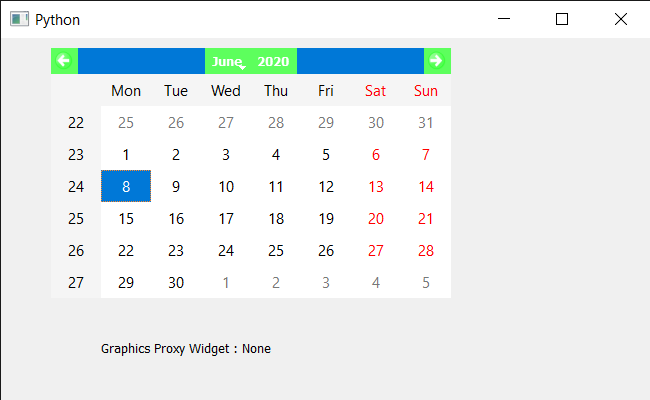En este artículo veremos cómo podemos obtener el widget de proxy gráfico del QCalendarWidget. El widget de proxy de gráficos devuelve el widget de proxy para el widget incrustado correspondiente en una vista de gráficos; de lo contrario, devuelve Ninguno.
Para hacer esto, usaremos
graphicsProxyWidgetel método con el objeto QCalendarWidget.Sintaxis: calendar.graphicsProxyWidget()
Argumento: no requiere argumento
Retorno: Devuelve el objeto QWidget
A continuación se muestra la implementación.
Python3
# importing libraries
from PyQt5.QtWidgets import *
from PyQt5 import QtCore, QtGui
from PyQt5.QtGui import *
from PyQt5.QtCore import *
import sys
class Window(QMainWindow):
def __init__(self):
super().__init__()
# setting title
self.setWindowTitle("Python ")
# setting geometry
self.setGeometry(100, 100, 650, 400)
# calling method
self.UiComponents()
# showing all the widgets
self.show()
# method for components
def UiComponents(self):
# creating a QCalendarWidget object
self.calendar = QCalendarWidget(self)
# setting geometry to the calendar
self.calendar.setGeometry(50, 10, 400, 250)
# setting cursor
self.calendar.setCursor(Qt.PointingHandCursor)
# creating a color graphic effect
color = QGraphicsColorizeEffect()
color.setColor(Qt.green)
# setting graphics to the calendar
self.calendar.setGraphicsEffect(color)
# creating label to show the properties
self.label = QLabel(self)
# setting geometry to the label
self.label.setGeometry(100, 280, 250, 60)
# making label multi line
self.label.setWordWrap(True)
# getting graphics proxy widget if there is any
value = self.calendar.graphicsProxyWidget()
# setting text to the label
self.label.setText("Graphics Proxy Widget : " + str(value))
# create pyqt5 app
App = QApplication(sys.argv)
# create the instance of our Window
window = Window()
# start the app
sys.exit(App.exec())
Producción :
Publicación traducida automáticamente
Artículo escrito por rakshitarora y traducido por Barcelona Geeks. The original can be accessed here. Licence: CCBY-SA